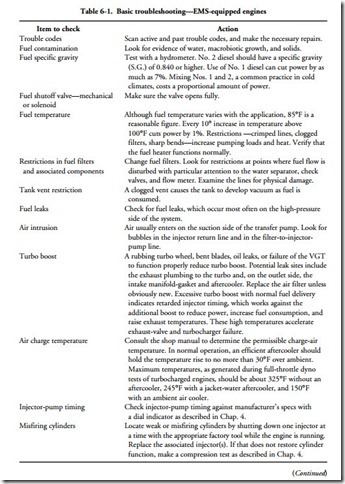Troubleshooting
As far as they go, the troubleshooting procedures described in Chap. 4 apply to computerized engines. For example, blue- or blue-gray smoke means lube oil is being burned. Oil can enter the chambers by way of faulty valve or turbo seals, or past worn piston rings. EMC-equipped engines may have additional sources of oil intrusion, such as HEUI injector seals.
The first step in troubleshooting is to interview the operator to obtain as much information as possible about the complaint that might have nothing to do with the engine. For example, a truck driver’s technique (or lack of it), vehicle efficiency, or operating conditions (such as weather, loads, and fuel) can have serious effects upon engine performance and fuel economy. Custom-built fixed and marine installations require careful scrutiny to make sure they have been designed properly.
Once the problem has been narrowed down to the engine, walk around the unit looking for anything amiss, with emphasis on the cooling, air inlet, exhaust, and fuel systems. Table 6-1 is a generalized troubleshooting guide. More specific procedures are provided in the sections that deal with Caterpillar and Ford systems.
CAUTION: Do not disconnect or make up harness connectors or actuators while the engine is running or with the ignition key “on.” The resulting voltage spikes can damage the computer.
Low-pressure fuel circuits should be tested for transfer-pump pressure, air leaks, and restrictions as described in Chap. 4 and in more detail in this chapter.
High-pressure fuel circuits take us into the realm of diagnostic trouble codes (DTCs) and highly specific repair procedures for which engine manufacturers issue multi-volume service manuals. But while no serious repair effort should be contem- plated without this documentation, certain generalizations can be made.
Broadly speaking, the most vulnerable components are:
• Harness connectors. Look for misaligned or loose connector pins, and for evidence of overheating. Wiggling the harness can sometimes reveal loose pin connections that generate transient faults in service. Arrange harness clamps to provide slack at the connectors.
• Sensors and sensor wiring. Most sensors have three leads—voltage input, voltage output, and ground. Determine that voltage is present (which means that the input circuit is probably okay) and that the output is neither shorted to ground nor open. Bad grounds, that is, loose tie-downs, rust, paint, or
Governor seals Look for damage to factory-sealed adjustments that, for example, can indicate that governed idle speed has been increased in an attempt to boost full-throttle power output. Using an accurate tachometer (not the control-panel unit), compare idle speed against the factory specification.
grease on the chassis or engine ground studs—can affect any circuit and generate noise that is fatal for band-width signals. If the circuitry is functional, the problem lies with the sensor that, in the absence of factory documentation, should be tested by substitution of a known good one. The camshaft position sensor has been a chronic problem on some engines, the throttle-position sensor on others.
• Actuators that live in bad environments. Exhaust recirculation valves (EGR) carbon over and stick, the exhaust back-pressure valve on Power Stroke exhaust systems rusts and binds, injectors malfunction, and glow-plug control modules sometimes melt.
WARNING: Do not disconnect, test, or otherwise disturb injector wiring while the engine is running. Voltages are hazardous.
• Damage caused by contaminated fuel, off-road excursions, “high- performance” air filters and so on.
High-pressure components—computer-controlled injector pumps, fuel-pressure regulators and electronic injectors—do not lend themselves to field repair. Repairs must be accomplished by professionals equipped with the necessary test and calibration tooling. Denso has invested millions to upgrade its factory repair centers with Hartridge AVM2PC test benches.
Less expensive components—sensors, EGR valves, and control modules—are sacrificial items, discarded when they fail.
CAUTION: The speed of a diesel engine is entirely a function of fuel delivery. A mistake made when servicing the fuel system can result in a runaway engine. Caterpillar suggests that a helper stands by ready to block the air intake with a steel plate the first time the engine is started. The helper must be careful not to allow his fingers to be caught between the plate and the intake-manifold flange, especially if the engine is turbocharged.

